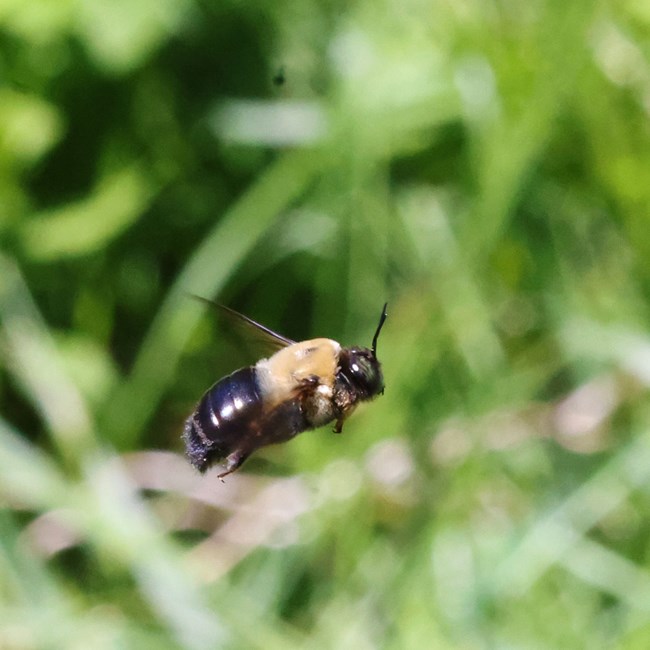Last updated: January 14, 2025
Article
Protecting Our Pollinators

NPS Photo/E. Bernbaum
Pollinators come in many forms. They can boast feathered, painted, and glassy wings. Some may have twirling antennae and iridescent shells; others flaunt curling tongues or furry faces. A few even have scaled tails.
But, all do the same deed. By going about their daily business, partaking in pollen and noshing on nectar, these creatures inadvertently collect and deliver pollen – that yellow, dusty fertilizer necessary for virtually all flowering plants to reproduce.
As pollinators fertilize flowers, they make it possible for plants to grow fruits and produce enough seed for adequate dispersal. Without pollinators, most flowering plants would die off. 80% of global crop plants and over 150 food crops in the U.S. would number among the deceased.
From evergreens to wildflowers and corn to coffee, pollinators make the world go ‘round. By keeping plant populations alive and diverse, flitting, buzzing, and scurrying pollinators also help supply oxygen to the air we breathe and remove carbon dioxide from the atmosphere. By supporting plants, they help prevent erosion and play a key role in cleaning our water.

NPS Photo/E. Bernbaum
Pollinators make life as we know it possible.
They are also in decline, like many species today. They suffer from pesticide poisoning, disease exacerbated by human action, overcrowding due to invasive species, habitat loss due to encroachment, drought, wildfire, light pollution, and other climate-change-related threats.
Their dramatically diminished populations alarm scientists and stewards of all stripes. To take action, the Boston Harbor Islands National and State Park partners with researchers to track pollinator populations.
In 2011, the park completed a six-years-long survey of insects and other small animals with Harvard’s Museum of Comparative Zoology and the Boston Harbor Islands Partnership. In 2015, the park and partners at the University of Massachusetts Boston piloted a study that began tracking native bee abundance and diversity across islands.
This year, in 2024, the park is partnering with researchers from Tufts and Rutgers to keep our bee monitoring efforts afloat and establish a new protocol for consistent data collection. Net in hand, researchers scour Bumpkin, Grape, Peddocks, and Spectacle Island meadows and flower beds for bees to identify and count.
These studies help NPS monitor bee health, inform choices about plants that we remove and restore, and give us a sense of what other protective actions park managers ought to take.

NPS Photo/E. Bernbaum
Outside of research efforts, the Boston Harbor Islands National and State Park’s Science & Stewardship team also helps native bees, butterflies, and other important pollinators by supporting and restoring their habitat. The team removes invasive plants that crowd out native species and protects native species that pollinators rely on – like native milkweed.
Native milkweed is a key species for monarch butterflies, who have declined globally by over 80% within the past two decades. Each fall, monarchs stop by the Boston Harbor Islands on their migration route from New England and Canada to southwestern Mexico, making the Harbor Islands a critical refuge for these weary winged travelers.
The park and partners also work to protect important pollinator habitats from the encroachment of human industry and work to educate people about the actions that we can take together to protect pollinators.
If you’d like to help the park’s Science & Stewardship team support local and migrating pollinators, join us at our next Stewardship Saturday.
Here a few more things we can all do to help pollinators:
- Plant native flowers that bloom at different times. Native plants can offer pollinators food and safe places to nest and take shelter from predators. Consider planting milkweed if you have a soft spot for the marvelous monarch.
- Remove invasive plants like swallow-wort, which, to a monarch, looks a lot like a milk weed but is toxic.
- Use boot brushes when requested. This helps limit the spread of invasive species and fungi that can harm pollinators. White-nose syndrome, for instance, has killed millions of bats since 2006 and is spread in part by humans.
- Avoid using chemicals that are known to harm pollinators – neonicotinoids for instance. Neonicotinoids are a likely culprit for honeybee colony collapse.
Contributed by: Elle Bernbaum, Biological Science Technician
